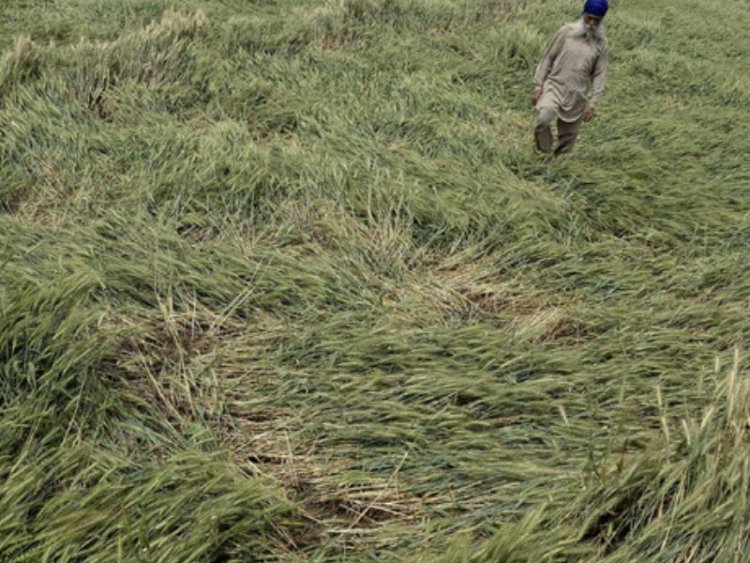Rains dash hopes of record wheat output, may stay at last year's level
10 to 30 per cent damage has been caused to lodging of crop in Punjab, Haryana and western Uttar Pradesh. In Madhya Pradesh too, wheat is soaked in water on a large scale after harvesting and its quality has been affected. Under these circumstances, it is not possible to achieve the target of 112 million tonnes of wheat production for the current year.

Unseasonal rains and hailstorm have dashed hopes of a record production of wheat crop in the current rabi season (2022-23). Government estimates of loss may take some time to come, but based on the assesment of the damage to the crop it can be said that wheat production this year may stuck at last year's level.
Teams of scientists from two institutes of the Indian Council of Agricultural Research (ICAR) have made ground assessment of the damage in Haryana and Punjab, as per which around 30 per cent of the crop has lodging problem due to rain and storm.
According to highly placed sources, 10 to 30 per cent damage has been caused to lodging of crop in Punjab, Haryana and western Uttar Pradesh. In Madhya Pradesh too, wheat is soaked in water on a large scale after harvesting and its quality has been affected. Under these circumstances, it is not possible to achieve the target of 112 million tonnes of wheat production for the current year.
A senior ICAR scientist told Rural Voice that wheat crop has been sown in 3.43 crore hectares in the country this rabi season (2022-23). On the basis of average production of three tonnes per hectare, the production of wheat works out to 102 million tonnes. Farmers in Punjab and Haryana get a yield of up to even seven tonnes per hectare. Given the favorable weather and better crop conditions till mid-March, there was a strong possibility that wheat production would exceed the government's target of 112 million tonnes. But unseasonal rains, winds and hailstorm turned the situation upside down.
Related story: Centre relaxes norms for wheat procurement from MP
According to a senior scientis from ICAR, it is for the first time that there have been unseasonal rains and hailstorm on such a wide scale in many states, which have adversely affected the crop. Another senior scientist told Rural Voice that the team of scientists inspected crop from Sonipat in Haryana to Sangrur in Punjab, some 200 km away, where lodging is about 30 per cent area. This assessment was done before March 29. It was on March 29 to 31, that the wheat producing states received heavy rains. The ICAR scientist said the crops standing at 60 degrees have little chance of damage, but for those which are completely fallen, the damage can be very high.
Wheat plants in Punjab, Haryana and western Uttar Pradesh are in the process of grain formation and drying during the rains. In such a situation, the supply of nutrients from the stem to the earheads of the plants which have fallen down will be affected. Food elements from photosynthesis in fallen plants are also affected.
The crop which was sown before November 15 had formed grains and was at drying stage. But the crop sown after that was in milking stage. There is a possibility of more loss in such crop. In Rajasthan's Kota and Bundi area, where there has been hailstorm at the stage of ready crop, the damage has been huge. According to scientists, wheat crop has fallen more in those areas where farmers have used more nitrogen. Farmers in Punjab use more fertilisers for better yield. Here farmers use up to 150 kg nitrogen to get more than seven tonnes per hectare yield. More wheat crop has fallen in such areas. This thing has also been proved through the demonstration field of the Indian Agricultural Research Institute (IARI). The field where higher use of nitrogen was made completely lodged.
According to scientists, a major problem is the harvesting of fallen wheat. According to him, 10 per cent of the wheat is wasted due to sputtering during harvesting with the combine harvester. In such a situation, the option of manual harvesting can reduce this loss. But manual harvesting will increase the cost by at least Rs.1,000 per acre. The loss due to sputtering can also be reduced by harvesting with suction combine instead of normal combine. But the number of such combines is not much.
According to sources, the Karnal-based Indian Institute of Wheat and Barley Research (IIWBR) of ICAR have been asked to assess the crop damage. The Institute will submit report to ICAR which will forward it to the Ministry of Agriculture. This report is likely to be close to the kind of assessment given by agricultural scientists to Rural Voice.
Last year also the crop was affected
The sudden rise in temperature after March 15 in the last rabi season (2021-22) had badly affected the wheat crop. Due to this, there was a decline of 10 to 25 per cent in production in affected areas. The government had set a target of 111 million tonnes of wheat production last year, but reduced it to 107.7 million tonnes in 2021-22 due to the drastic change in temperature. But independent estimates put wheat production at around 95 million tonnes.
The government had set a target of 444 lakh tonnes of wheat procurement last rabi marketing season (2022-23) but due to shortfall in production and prices being above the minimum support price (MSP) of Rs 2,015 per quintal since the beginning of the season, government procurement was stuck at 187.92 lakh tonnes. That too after the government had banned wheat exports on May 13 and relaxed procurement norms.
This level of government procurement was the lowest in 15 years. At that time the prices in the global market had reached up to $500 per tonne, which have now come down to less than $250 per tonne. For the first time in December 2022, wheat prices had crossed Rs 3,000 per quintal in the domestic market.
The stock of wheat in the central pool stood at 154.44 lakh tonnes as on February 1, 2023, which was the lowest level in six years. To bring down the price of wheat, the government had to take a decision to sell 50 lakh tonnes of wheat in the open market.
The reserve price under the Open Market Sale Scheme (OMSS) was reduced to Rs 2,140.46 per quintal. The government has fixed the MSP of wheat at Rs 2,125 per quintal for the current marketing season (2023-24). In the current rabi marketing season, the government has set a target of procuring 341.50 lakh tonnes of wheat.
In the expectation of better price farmers had increased the area under wheat crop. Last year, where a sudden rise in temperature after March 15 affected production, unseasonal rains, strong wind and hailstorm around the same time this year badly damaged the wheat crop. In such a situation, this year also there has been a situation of production being less than the target.
Experts and scientists are not saying anything directly regarding estimated production, but there is talk of getting stuck at last year's level only. Now it will be important to see what figures the government releases regarding production.
The governments of Punjab and Haryana have started conducting ‘girdawaris’ to assess the damage. The kind of figures coming from it indicate a big decline in production.



 Join the RuralVoice whatsapp group
Join the RuralVoice whatsapp group








































